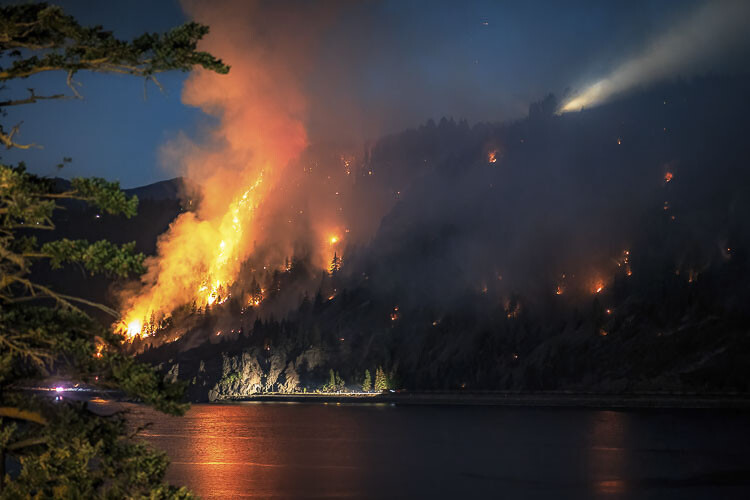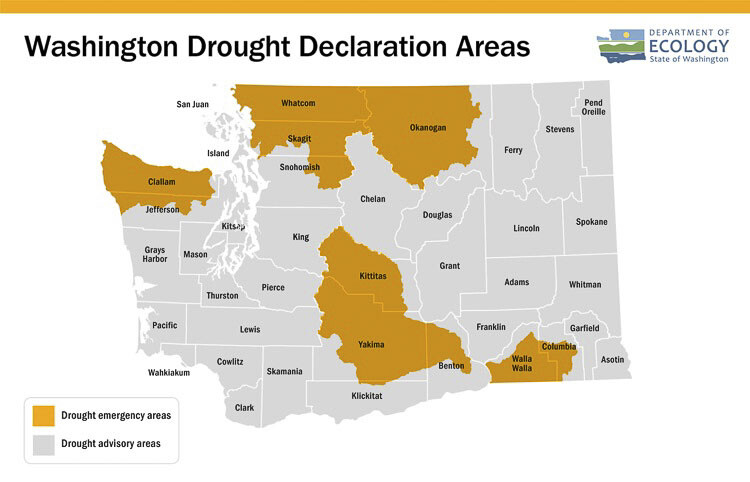
The announcement changes the classification of those counties from drought advisories to drought emergencies
Timothy Schumann
The Center Square Washington
With wildfire season in full swing in Washington, the Department of Ecology has issued a declaration covering 12 counties spanning west to east from Whatcom to Walla Walla.
The announcement Monday changes the classification of those counties, listed below, from drought advisories to drought emergencies, citing “early snowmelt, a lack of spring rain and low streamflows.”

The list of counties affected is as follows;
- Benton
- Clallam
- Columbia
- Jefferson
- Kittitas
- Klickitat
- Okanogan
- Skagit
- Snohomish
- Walla Walla
- Whatcom
- Yakima
A more detailed map of affected areas is available on the Department of Ecology’s website.
According to the Department of Ecology, drought emergencies are declared in Washington state when there is 75% or less than normal water supply, and there is an additional risk of hardship to communities.
Hardships such as “limits on water users with more junior water rights, difficulties with fish passage, and a need to truck in drinking water to residents” are already occurring in the counties listed in the declaration.
The declaration opens up legal avenues for granting emergency water rights permits as well as transfers of water rights to those in need.
Additionally, legislation passed earlier this spring makes $3 million in emergency drought relief funds available for disbursement in grant form to assist communities, irrigation districts, tribal governments, and other public entities facing hardships.
“This drought is already harming Washington communities, businesses and farms, and it’s another sign of the damage that climate change is causing to our state,” said Department of Ecology Director Laura Watson in a statement issued with the announcement. “Today’s drought declaration will help to rapidly deliver relief to these areas, but we need to also be taking steps to manage water wisely and prepare for a drier future.”
In the north, Nooksack Basin has three water systems currently operating on emergency status, and some wells have even gone dry.
On the western tip of the state, the Clallam County PUD is trucking in water due to low streamflow, with some areas such as Neah Bay placed on mandatory watering restrictions since mid-May.
In the eastern portion of the state covered by the Walla Walla basin, there have been reports that portions of the watershed have dried up completely, leading to crop losses.
Ria Berns, manager of the Department of Ecology’s Water Resources program, warns that what we’re seeing may be the new normal.
“Climate change is making warm, dry summers more frequent, and droughts more severe. What we’re seeing this year is likely a sign of things to come,” said Berns.
More information on drought preparedness for Washington residents is available on the Department of Ecology website.
This report was first published by The Center Square Washington.
Also read:
- Opinion: OIC tells consumers not to pay for ‘insurance’ you won’t likely benefit from: Does that include WA Cares?Elizabeth New (Hovde) of the Washington Policy Center believes you should consider yourself warned by the Office of the Insurance Commissioner about WA Cares and its maybe-only benefit.
- Opinion: Same road, different speed limit?Target Zero Manager Doug Dahl addresses a question about speed limit signs going into and leaving town.
- Progress being made at GRO Parade of Homes siteThe 2024 GRO Parade of Homes, presented by the Building Industry Association of Clark County, is a little more than a month away, and builders are busy completing the luxury homes before the big event, scheduled for Sept. 6 through 22 in Felida.
- Has trust in the media tanked over coverage of President Biden’s decline?After President Joe Biden’s calamitous debate performance against former President Donald Trump, and days after Biden’s decision Sunday not to seek reelection, there are still many questions about how the news media covered Biden’s mental and physical decline.
- Opinion: Hiding the growing cost of the Interstate Bridge replacementJoe Cortright of the City Observatory addresses the rising cost of the Interstate 5 Bridge replacement project.
- Letter: ‘This election I am NOT voting for Greg Cheney’Clark County resident Wynn Grcich shares her thoughts on Rep. Greg Cheney and the issue of fluoridation in area drinking water.
- Major gas line leak closes major arterial in Clark CountyFirefighters from Clark County Fire District 6 responded Thursday (July 25) afternoon to the scene of a major natural gas leak on NE 99th Street, directly in front of Columbia River High School.











